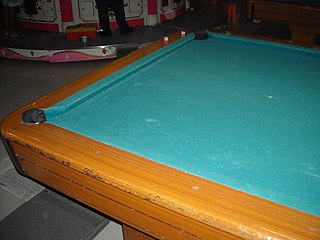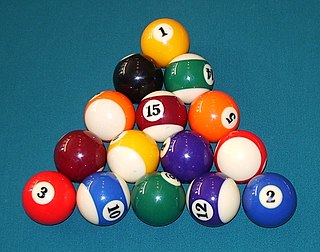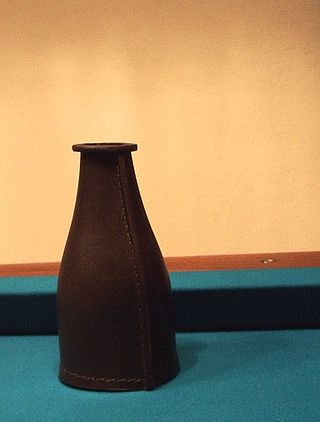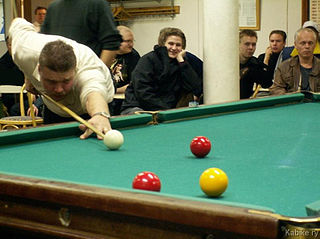Related Research Articles

Cue sports are a wide variety of games of skill played with a cue, which is used to strike billiard balls and thereby cause them to move around a cloth-covered table bounded by elastic bumpers known as cushions. Cue sports are also collectively referred to as billiards, though this term has more specific connotations in some varieties of English.

Eight-ball is a discipline of pool played on a billiard table with six pockets, cue sticks, and sixteen billiard balls. The object balls include seven solid-colored balls numbered 1 through 7, seven striped balls numbered 9 through 15, and the black 8 ball. After the balls are scattered with a break shot, a player is assigned either the group of solid or striped balls once they have legally pocketed a ball from that group. The object of the game is to legally pocket the 8-ball in a "called" pocket, which can only be done after all of the balls from a player's assigned group have been cleared from the table.

Nine-ball is a discipline of the cue sport pool. The game's origins are traceable to the 1920s in the United States. It is played on a rectangular billiard table with pockets at each of the four corners and in the middle of each long side. Using a cue stick, players must strike the white cue ball to pocket nine colored billiard balls, hitting them in ascending numerical order. An individual game is won by the player pocketing the 9-ball. Matches are usually played as a race to a set number of racks, with the player who reaches the set number winning the match.

Straight pool, which is also called 14.1 continuous and 14.1 rack, is a cue sport in which two competing players attempt to pocket as many object balls as possible without playing a foul. The game was the primary version of pool played in professional competition until it was superseded by faster-playing games like nine-ball and eight-ball in the 1980s.

One-pocket is a pool game. Only one pocket for each player is used in this game, unlike other games played on a pool table where any pocket can be used to score object balls. The object of the game is to score points. A point is made when a player pockets any object ball into their designated pocket. The winner is the first to score an agreed-upon number of points.
Golf billiards is a pocket billiards game usually played for money. Unlike the majority of such games, it allows more than two people to play without compromises or rule changes. The game borrows from the outdoor game of golf, which is historically related to the cue sports. It is usually played on 10-foot or 12-foot snooker tables as their size and structure are more appropriate. In 2006 the Billiard Congress of America commented it was more popular than snooker in the United States.

Russian pyramid, also known as Russian billiards, is a form of billiards played on a large billiard table with narrow pockets. It is played across Russia and several former Soviet/Eastern Bloc countries. In the West, the game is known as pyramid billiards, or simply pyramid.

Pool is the name given to a series of cue sports played on a billiard table. The table has six pockets along the rails, into which balls are shot. Of the many different pool games, the most popular include: eight-ball, blackball, nine-ball, ten-ball, seven-ball, straight pool, one-pocket, and bank pool. Eight-ball is the most frequently played discipline of pool, and it is often thought of as synonymous with "pool".
Bank pool is a pool game that has as its most fundamental requirement that all scoring shots in the game must be made by banking a called ball off a cushion and into a called pocket.
The following is a glossary of traditional English-language terms used in the three overarching cue sports disciplines: carom billiards referring to the various carom games played on a billiard table without pockets; pool, which denotes a host of games played on a table with six pockets; and snooker, played on a large pocket table, and which has a sport culture unto itself distinct from pool. There are also games such as English billiards that include aspects of multiple disciplines.

Rotation, sometimes called rotation pool, 15-ball rotation, or 61, is a pool game, played with a pocketed billiards table, cue ball, and triangular rack of fifteen billiard balls, in which the lowest-numbered object ball on the table must be always struck by the cue ball first, to attempt to pocket numbered balls for points.

Three-ball is a folk game of pool played with any three standard pool object balls and cue ball. The game is frequently gambled upon. The goal is to pocket the three object balls in as few shots as possible. The game involves a somewhat more significant amount of luck than either nine-ball or eight-ball, because of the disproportionate value of pocketing balls on the break shot and increased difficulty of doing so. In some areas and subcultures, such as the Asian-American youth-dominated pool hall scene of San Francisco, California, three-ball is a popular local tournament game.
Chicago is a "money ball" pool gambling game.
Cowboy pool is a hybrid pool game combining elements of English billiards through an intermediary game, with more standard pocket billiards characteristics. The game employs four balls, the cue ball and three others, numbered one, three, and five. A game of Cowboy pool is contested as a race to 101 points, with those points being awarded for a host of different shot types. Dating back to 1908, the game is a strictly amateur pastime.

Five-pin billiards or simply five-pins or 5-pins, is today usually a carom billiards form of cue sport, though sometimes still played on a pocket table. In addition to the customary three balls of most carom games, it makes use of a set of five upright pins (skittles) arranged in a "+" pattern at the center of the table. The game is popular especially in Italy and Argentina, but also in some other parts of Latin America and Europe, with international, televised professional tournaments. It is sometimes referred to as Italian five-pins or Italian billiards, or as simply italiana. A variant of the game, goriziana or nine-pins, adds additional skittles to the formation. A related pocket game, with larger pins, is played in Scandinavia and is referred to in English as Danish pin billiards, with a Swedish variant that has some rules more similar to the Italian game.

Baseball pocket billiards or baseball pool is a pocket billiards (pool) that is loosely based on the game of baseball. The game is played on a standard pool table and suitable for multiple players. In baseball pocket billiards, many of the game's features are named after baseball terms, such as the 9 ball being named the "pitcher", the table's foot spot is "home plate", and each team or player is afforded "nine innings" to score as many "runs" as possible.

Bottle pool, also known as bottle-billiards and bottle pocket billiards, is a hybrid billiards game combining aspects of both carom billiards and pocket billiards. Played on a standard pool table, the game uses just two object balls, a cue ball, and a 6+3⁄4 inches (170 mm) tall, narrow-necked bottle called a shake bottle or tally bottle, traditionally made from leather, that is placed on the table and used as a target for caroms. Those unfamiliar with the game sometimes mistakenly use its name as a synonym for the very different game of kelly pool. Bottle pool has been described as combining "elements of billiards, straight pool and chess under a set of rules that lavishly rewards strategic shot making and punishes mistakes with Sisyphean point reversals."

Cribbage, sometimes called cribbage pool, fifteen points and pair pool, is a two-player pool game that, like its namesake card game, has a scoring system which awards points for pairing groups of balls that total 15. Played on a standard pool table, participants who pocket a ball of a particular number are required to immediately pocket the companion ball that tallies to 15 when added to the prior ball's number. Each pair so pocketed counts as a cribbage; there are seven such pairs, and the 15 ball counts as an eighth by itself after all of the others have been pocketed. The first player to score five cribbages wins the game.

Kaisa or karoliina is a cue sport mainly played in Finland. The game originated in Russia, where it is still played to some extent. Kaisa equipment is similar to Russian pyramid from the 68 mm balls, small pockets barely large enough for a ball to enter, and the long and heavy cue sticks. Kaisa tables are usually 10 feet long, and thus 2 feet shorter than official tournament Russian pyramid tables, which are 12 feet long. It is a two-player or two-team game. As with many carom billiards games, both players have their own cue balls used to shoot at the other balls, and usually differentiated by one cue ball having a dot or other marking on it. In all, five balls are used: the yellow object ball, two red object balls, and the two white cue balls. The game is played to 60 points, in a rather elaborate scoring system, reminiscent of those used in snooker and English billiards, with points being awarded for various types of shots. Like both Russian and English billiards, which are also played on large pocket billiards tables, kaisa is a hybrid of carom and pocket billiards game styles. Kaisa is principally a recreational game, without professional players. However, the first kaisa world championship tournament was held in April 2010. Participants came from 33 countries, and the main tournament was held in Kotka. A Finnish player, Marko Rautiainen, won the championship title.

Fifteen-ball pool, also known as sixty-one pool, is a pocket billiards game developed in America in the nineteenth century from pyramid pool. Created by members of the Bassford's Billiard & Chess Rooms in Manhattan during the late 1830s or 1840s, it is the ancestor to many American pool games.
References
This article includes a list of general references, but it lacks sufficient corresponding inline citations .(September 2016) |
- ↑ "29 Ball Color Set". Eagle Pool Balls. July 24, 2010 – via YouTube.com.
{{cite web}}: Missing or empty|url=(help) - ↑ United States Patent 6902490, http://www.freepatentsonline.com/6902490.html
- "Cutthroat Billiards Rules". BilliardsForum.com. 2006. Archived from the original on October 27, 2017. Retrieved October 26, 2017.
- Taylor, Kelly (2017). "Pool Games for Three People". Healthfully.com. Leaf Group. Archived from the original on October 27, 2017. Retrieved October 26, 2017.
